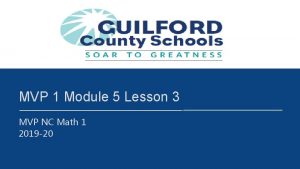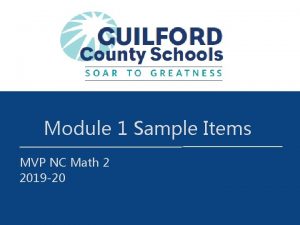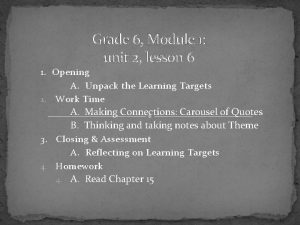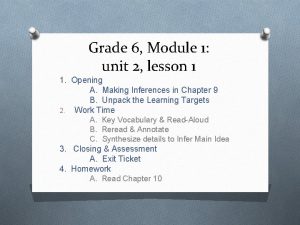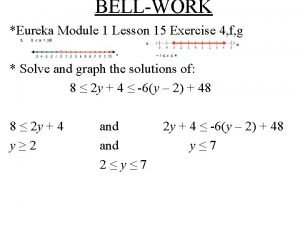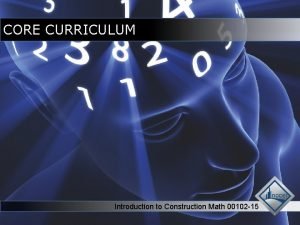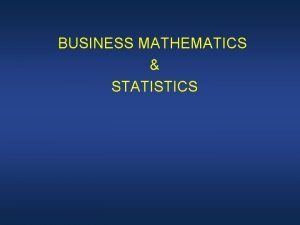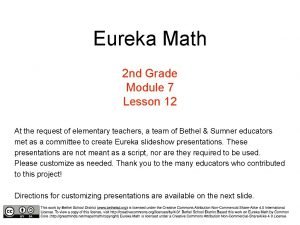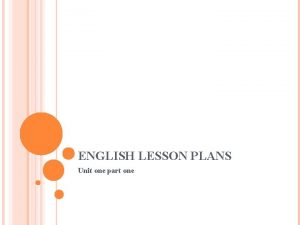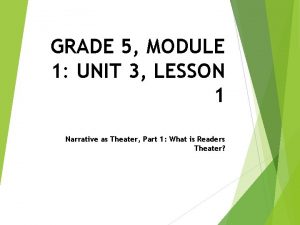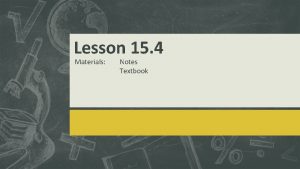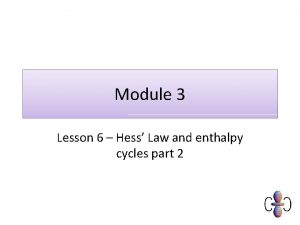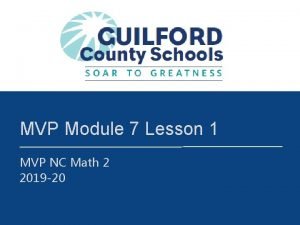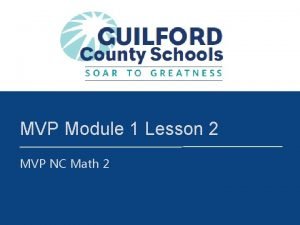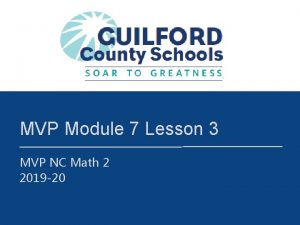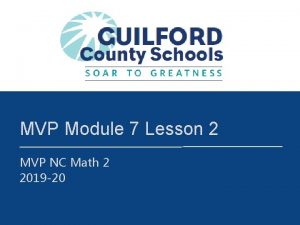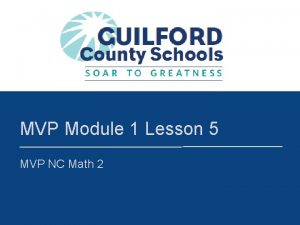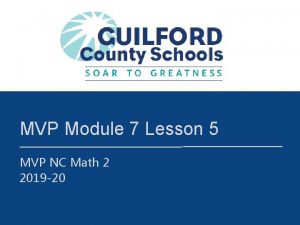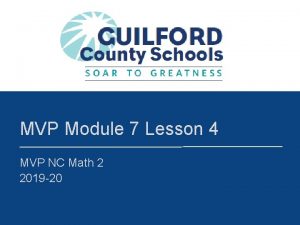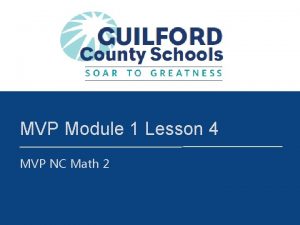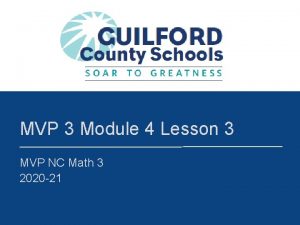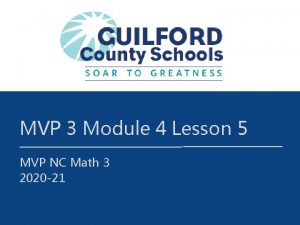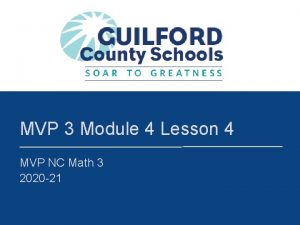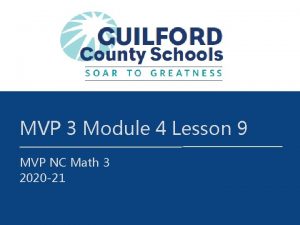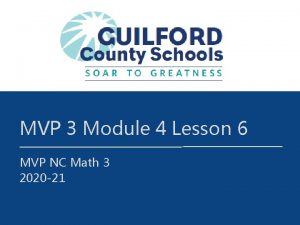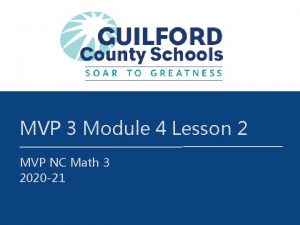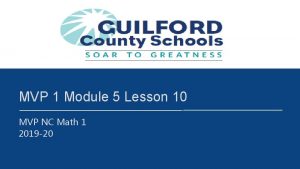MVP Module 1 Lesson 6 MVP NC Math





























- Slides: 29

MVP Module 1 Lesson 6 MVP NC Math 2

Warm-Up Pre. K-12 Mathematics

Lesson Essential Question What observations can I make about different types of quadrilaterals based on their lines of symmetry and rotational symmetry? Pre. K-12 Mathematics

Lesson 6: Quadrilateral – Beyond Definition A Practice Understanding Task Pre. K-12 Mathematics

We have found that many different quadrilaterals possess lines of symmetry and/or rotational symmetry. In the following chart, write the names of the quadrilaterals that are being described in terms of their symmetries.

What do you notice about the relationships between quadrilaterals based on their symmetries and highlighted in the structure of the above chart?

1. A rectangle is a quadrilateral that contains four right angles. Based on what you know about transformations, what else can we say about rectangles besides the defining property that “all four angles are right angles? ”

Make a list of additional properties of rectangles that seem to be true based on the transformation(s) of the rectangle onto itself. You will want to consider properties of the sides, angles and diagonals. Then, justify why the properties would be true using transformational symmetry.

2. A parallelogram is a quadrilateral in which opposite sides are parallel. Based on what you know about transformations, what else can we say about parallelograms besides the defining property that “opposite sides of a parallelogram are parallel? ”

Make a list of additional properties of parallelograms that seem to be true based on the transformation(s) of the parallelogram onto itself. You will want to consider properties of the sides, angles and diagonals. Then, justify why the properties would be true using transformational symmetry.

3. A rhombus is a quadrilateral in which all four sides are congruent. Based on what you know about transformations, what else can we say about rhombuses besides the defining property that “all sides are congruent? ” Pre. K-12 Mathematics

Make a list of additional properties of rhombuses that seem to be true based on the transformation(s) of the rhombus onto itself. You will want to consider properties of the sides, angles and diagonals. Then, justify why the properties would be true using transformational symmetry. Pre. K-12 Mathematics

4. A square is a rectangle and a rhombus. Based on what you know about transformations, what can we say about a square? Pre. K-12 Mathematics

Make a list of additional properties of squares that seem to be true based on the transformation(s) of the square onto itself. You will want to consider properties of the sides, angles and diagonals. Then, justify why the properties would be true using transformational symmetry. Pre. K-12 Mathematics

In the following chart, write the names of the quadrilaterals that are being described in terms of their features and properties, and then record any additional features or properties of that type of quadrilateral you may have observed. Be prepared to share reasons for your observations. Pre. K-12 Mathematics

What do you notice about the relationships between quadrilateral based on their characteristics and the structure of the above chart? Pre. K-12 Mathematics

• How are the charts at the beginning and end of this task related? • What do they suggest? Pre. K-12 Mathematics

READY? Topic: Defining congruence and similarity. Pre. K-12 Mathematics

1. What do you know about two figures if they are congruent? Pre. K-12 Mathematics

2. What do you need to know about to figures to be convinced they are congruent? Pre. K-12 Mathematics

3. What do you know about two figures if they are similar? Pre. K-12 Mathematics

4. What do you need to know about two figures to be convinced that they are similar? Pre. K-12 Mathematics

SET Topic: Classifying quadrilaterals based on their properties

Use the information given to determine the most accurate classification of the quadrilateral. 5. Has 180° rotational symmetry 6. Has 90° rotational symmetry 7. Has two lines of symmetry that are diagonals 8. Has two lines of symmetry that are not diagonals.

Use the information given to determine the most accurate classification of the quadrilateral. 9. Has congruent diagonals 10. Has diagonals that bisect each other 11. Has diagonals that are perpendicular 12. Has congruent angles

GO! Topic: Calculating slope and distance

Find the slope between each pair of points. Then, using the Pythagorean theorem, find the distance between each pair of points. Distances should be provided in the most exact form.

Find the slope between each pair of points. Then, using the Pythagorean theorem, find the distance between each pair of points. Distances should be provided in the most exact form.

EXIT TICKET Explain how you know the diagonals of a rectangle are congruent.
 Mvp math 1
Mvp math 1 Mvp math 2
Mvp math 2 Unit 2 lesson 6
Unit 2 lesson 6 Grade 6 module
Grade 6 module Eureka math algebra 1 module 1 lesson 15
Eureka math algebra 1 module 1 lesson 15 C device module module 1
C device module module 1 Mvp dropbox
Mvp dropbox Mvp minimum viable product
Mvp minimum viable product Microsoft mvp certification
Microsoft mvp certification Aka.ms.sqlcapacity
Aka.ms.sqlcapacity Bcgsoft 사용법
Bcgsoft 사용법 Mvp surface sampling device
Mvp surface sampling device Mvp
Mvp Minimum viable product powerpoint template
Minimum viable product powerpoint template Minimum viable product template excel
Minimum viable product template excel Mvp corect ltd
Mvp corect ltd Anton boyko
Anton boyko Pilot mvp
Pilot mvp Nccer introduction to construction math answers
Nccer introduction to construction math answers Proportion business math
Proportion business math Eureka math algebra 1 module 4
Eureka math algebra 1 module 4 Eureka math 3rd grade module 7
Eureka math 3rd grade module 7 Hit the button
Hit the button Module 9 lesson 2
Module 9 lesson 2 Module 5 lesson 5
Module 5 lesson 5 Module 1 lesson 1 family relationships
Module 1 lesson 1 family relationships Module eleven lesson one self check quiz
Module eleven lesson one self check quiz Grade 5 module 1 lesson 1
Grade 5 module 1 lesson 1 Module 15 lesson 1 central angles and inscribed angles
Module 15 lesson 1 central angles and inscribed angles Module 3 lesson 6
Module 3 lesson 6
